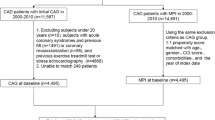Abstract
Aims
To evaluate whether the corrected thrombolysis in myocardial infarction frame count (CTFC), an index of resting coronary blood flow, is associated with the risk of major adverse cardiovascular events (MACE) in patients with suspected stable angina pectoris (SAP) but no obstructive coronary artery disease (CAD) at angiography.
Methods and results
In this case–control study, CTFC at baseline in 127 patients (50 % women) who subsequently experienced a myocardial infarction, non-hemorrhagic stroke or cardiovascular death during 2001–2011 was compared with CTFC in 254 event-free matched controls. All patients had suspected SAP but no obstructive (≥50 % stenosis) CAD at baseline angiography. Mean CTFC in controls was 23.4 (95 % confidence interval 20.9–25.9) frames and mean CTFC in cases did not differ significantly with a difference of −1.0 (−3.1 to 1.1) frames (P = 0.35) and no sex-specific interaction (P = 0.18). In a conditional logistic regression model, we found no dose–response relationship between CTFC and the risk of MACE, i.e., compared to the risk in the lowest CTFC quintile, the odds ratios for MACE were 1.3 (0.7–2.6), 0.7 (0.3–1.3), 0.7 (0.4–1.5) and 1.0 (0.5–2.1) in the second, third, fourth and fifth CTFC quintiles, respectively. Adjustment for cardiac risk factors including diabetes, active smoking, body mass index, and use of lipid-lowering and antihypertensive medication did not significantly change the results.
Conclusions
In patients with SAP symptoms without obstructive CAD at angiography, CTFC is not associated with the risk of MACE.


Similar content being viewed by others
References
Jespersen L, Hvelplund A, Abildstrom SZ, Pedersen F, Galatius S, Madsen JK et al (2012) Stable angina pectoris with no obstructive coronary artery disease is associated with increased risks of major adverse cardiovascular events. Eur Heart J 33:734–744
Jespersen L, Abildstrom SZ, Hvelplund A, Prescott E (2013) Persistent angina: highly prevalent and associated with long-term anxiety, depression, low physical functioning, and quality of life in stable angina pectoris. Clin Res Cardiol 102:571–581
Cannon RO III, Epstein SE (1988) Microvascular angina as a cause of chest pain with angiographically normal coronary arteries. Am J Cardiol 61:1338–1343
Buchthal SD, den Hollander JA, Merz CNB, Rogers WJ, Pepine CJ, Reichek N et al (2000) Abnormal myocardial phosphorus-31 nuclear magnetic resonance spectroscopy in women with chest pain but normal coronary angiograms. N Engl J Med 342:829–835
Pepine CJ, Anderson RD, Sharaf BL, Reis SE, Smith KM, Handberg EM et al (2010) Coronary microvascular reactivity to adenosine predicts adverse outcome in women evaluated for suspected ischemia: results from the national heart, lung and blood institute wise (women’s ischemia syndrome evaluation) study. J Am Coll Cardiol 55:2825–2832
Ong P, Athanasiadis A, Mahrholdt H, Borgulya G, Sechtem U, Kaski J (2012) Increased coronary vasoconstrictor response to acetylcholine in women with chest pain and normal coronary arteriograms (cardiac syndrome X). Clin Res Cardiol 101:673–681
Suwaidi JA, Hamasaki S, Higano ST, Nishimura RA, Holmes DR Jr, Lerman A (2000) Long-term follow-up of patients with mild coronary artery disease and endothelial dysfunction. Circulation 101:948–954
Halcox JPJ, Schenke WH, Zalos G, Mincemoyer R, Prasad A, Waclawiw MA et al (2002) Prognostic value of coronary vascular endothelial dysfunction. Circulation 106:653–658
von Mering GO, Arant CB, Wessel TR, McGorray SP, Merz CNB, Sharaf BL et al (2004) Abnormal coronary vasomotion as a prognostic indicator of cardiovascular events in women: results from the national heart, lung, and blood institute-sponsored women’s ischemia syndrome evaluation (WISE). Circulation 109:722–725
Gibson CM, Cannon CP, Daley WL, Dodge JT, Alexander B, Marble SJ et al (1996) TIMI frame count. Circulation 93:879–888
Vijayalakshmi K, Ashton VJ, Wright RA, Hall JA, Stewart MJ, Davies A et al (2004) Corrected TIMI frame count: applicability in modern digital catheter laboratories when different frame acquisition rates are used. Catheter Cardiovasc Interv 63:426–432
Shaw LJ, Bugiardini R, Merz CNB (2009) Women and ischemic heart disease: evolving knowledge. J Am Coll Cardiol 54:1561–1575
Kunadian V, Harrigan C, Zorkun C, Palmer A, Ogando K, Biller L et al (2009) Use of the TIMI frame count in the assessment of coronary artery blood flow and microvascular function over the past 15-years. J Thromb Thrombolysis 27:316–328
Ong P, Athanasiadis A, Borgulya G, Mahrholdt H, Kaski JC, Sechtem U (2012) High prevalence of a pathological response to acetylcholine testing in patients with stable angina pectoris and unobstructed coronary arteries: The ACOVA study (Abnormal COronary VAsomotion in patients with stable angina and unobstructed coronary arteries). J Am Coll Cardiol 59:655–662
Bugiardini R, Manfrini O, Pizzi C, Fontana F, Morgagni G (2004) Endothelial function predicts future development of coronary artery disease: a study of women with chest pain and normal coronary angiograms. Circulation 109:2518–2523
Fragasso G, Chierchia SL, Arioli F, Carandente O, Gerosa S, Carlino M et al (2009) Coronary slow-flow causing transient myocardial hypoperfusion in patients with cardiac syndrome X: long-term clinical and functional prognosis. Int J Cardiol 137:137–144
Yonaha O, Matsubara T, Naruse K, Ishii H, Murohara T, Nakamura J et al (2008) Effects of reduced coronary flow reserve on left ventricular function in type 2 diabetes. Diabetes Res Clin Pract 82:98–103
Turhan H, Erbay AR, Yasar AS, Bicer A, Sasmaz H, Yetkin E (2004) Impaired coronary blood flow in patients with metabolic syndrome: documented by thrombolysis in myocardial infarction (TIMI) frame count method. Am Heart J 148:789–794
Abaci A, Oguzhan A, Eryol NK, Ergin A (1999) Effect of potential confounding factors on the thrombolysis in myocardial infarction (TIMI) trial frame count and its reproducibility. Circulation 100:2219–2223
Acknowledgments
The invasive cardiologists at Bispebjerg and Gentofte University Hospitals, Copenhagen, Denmark are acknowledged for support.
Conflict of interest
None.
Author information
Authors and Affiliations
Corresponding author
Rights and permissions
About this article
Cite this article
Jespersen, L., Abildstrøm, S.Z., Peña, A. et al. Predictive value of the corrected TIMI frame count in patients with suspected angina pectoris but no obstructive coronary artery disease at angiography. Clin Res Cardiol 103, 381–387 (2014). https://doi.org/10.1007/s00392-014-0665-7
Received:
Accepted:
Published:
Issue Date:
DOI: https://doi.org/10.1007/s00392-014-0665-7




